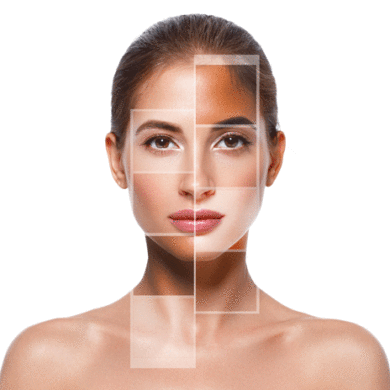Doctors who use mandelic skin care get better results:
Doctors who use mandelic acid get amazing results. Since 2012, Melanopeel has been an elite private clinical skin care line dispensing mandelic acid based skin transformations. The need for a more extensive range of mandelic acid skin care products was bourne out of the scarcity of mandelic acid preparations for home use.
Our first experience with mandelic acid skin care was through mandelic acid peels popular in Europe & Italy. In the U.S.A, renowned Laser Specialist & Dermatologist, Dr. Mark B. Taylor of the Gateway Aesthetic Institute and Laser Center was also known for the creation of excellent mandelic acid products. Dr. Taylor, based in Utah, created the popular line M2 Skin Care & Mama Lotion, with published research on mandelic acid. His research has concluded that –
“Full-face iontophoresis of vitamin C appears to be an effective short-term treatment for melasma and postinflammatory hyperpigmentation. A protocol of strict sun avoidance in combination with a mandelic/malic acid skin care regimen appears to be useful in maintaining the improvement.”
So, we’ve known for a while that mandelic acid is excellent. Dr. Taylor continues to innovate, update and improve his cosmetic dermatology results with multi-modal treatments.

He has mentored some of the most progressive physicians in the field of aesthetic medicine, including Dr. Desmer Destang. This physician has been lecturing on & extolling the benefits of mandelic acid for several years for managing acne, hyperpigmentation & melasma on skin of color. She has been instrumental in the conception & protocol-planning for the use of Melanopeel mandelic acids on darker & ethnic skin.
Her role has been to highlight and increase the sensitivity of mandelic acid benefits to both clinicians and also the public. Her practice in the Caribbean excels in pigmentation & acne management, due to her commitment to Melanopeel. The same goes for other Caribbean & physicians world-wide using similar protocols. With so many different mandelic acid blends, each Melanopeel physician is able to formulate their own customized patient regimes. Learn some of the several benefits of mandelic acid.
The science of mandelic acid:
Mandelic acid is an alpha hydroxy acid (AHA), with a long & safe history of medical use, as an anti-microbial. Research has determined that mandelic acid has anti-inflammatory, anti-bacterial, and anti-fungal activity.
This is one reason why mandelic acid is a preferable approach in treating and preventing acne, due to it’s antibacterial effect. Prior to being a skin care mainstay, mandelic acid has been widely used as an antiseptic for urinary problems. Mandelic acid is strongly antibacterial, and with it’s high safety profile has even been used as an oral antibiotic.
When used topically to treat acne or to prepare the skin for laser procedures, mandelic acid kills and prevents bacterial growth. When acne-causing bacteria in the skin are killed, skin inflammation and irritation are also greatly reduced. In the treatment of skin conditions, mandelic acid has several unique properties that make it desirable and effective in transforming the skin.
Mandelic acid is derived from bitter almonds. In the purified form, mandelic acid can be used for antiseptic, antibiotic, and anti-acne purposes. Mandelic acid is also the safest acid for dark skin tones such as African, Hispanic, Indian and Mediterranean skin.
Mandelic acid is different from other alpha hydroxy acids by being an aromatic hydroxy acid. This is good, as this large molecular structure allows mandelic acid to better bind to oils and oily skin.
We have found that mandelic acid is more remarkable than glycolic acid for exotic skin, since most clinical trials resulted in lesser skin irritation after its use. It should be noted that for people who undergo glycolic acid skin treatments, they would typically experience skin downtime (skin peeling, irritation, inflammation, redness, etc) after treatment. However, people who used mandelic acid, skin downtime is minimal or even non-existent.
Mandelic Acid for Reducing Acne, Skin Discolorations, Sun-damage, and Melasma
Melanopeel really knows & understands mandelic acid. Melanopeel’s mandelic acid formulations work well for acne, folliculitis (razor bumps & ingrown hairs) discolorations & melasma. If you are trying to balance uneven skin tone, get rid of the effects of dark spots on the face, treat inflammation from acne and repair sun damage, you will find that chemical peels comprising of alpha hydroxy acids (AHAs) like mandelic acid peel can turn out to be immensely effective.
Treating oily skin, acne & folliculitis:
Mandelic acid treatments and peels are a viable choice for those suffering from acne because they have an antibacterial effect and are quite gentle. The products are able to unclog pores without causing excessive irritation. One of the unique and appealing factors about this acid is that it can be safely used on darkly pigmented skin as opposed to glycolic acid and others. Remember that mandelic acid loves oily skin, and is antibacterial. Acne & folliculitis (inflammation of the hair follicles) conditions like razor bumps & ingrown hairs have an excess of bacterial inflammation. Therefore acne sufferers as well as those with razor bumps & ingrown hairs will all benefit from mandelic acid treatments.
Treating hyperpigmentation & melasma:
The amazing ability of mandelic to even out skin tones & lighten pigmentation suggests that it has the ability to down-regulate of melanocytes, the cells that produce melanin. Targeted treatments with mandelic acid skin care & peels can prove to be immensely beneficial to those dealing with any skin discolorations such as melasma, uneven skin tone, and and post-inflammatory hyperpigmentation (PIH) caused by acne.
Treating sun-damaged & aging skin:
Sun-damaged skin suffers multiple issues as a result of damage deep within the skin. All skin cells are affected by ultra-violet (UV) damage. This means that the cells producing melanin are damaged and cause spotty skin discolorations, cells producing collagen are damaged by enzymes called Matrix Metalloproteinases (MMPs), the skin’s DNA undergoes mutations, predisposing the skin to melanoma cancer, skin becomes less elastic and suffers from skin thickening called solar elastosis, and skin generally becomes more wrinkled.
Mandelic acid works to improve sun-damaged skin by:
- Resurfacing rough damaged skin
- Reducing skin inflammation
- Reducing hyperpigmentation
- Encouraging production of fresh new undamaged skin cells from the skin’s regenerative basal layer
- Antioxidant action of mandelic acid protects the skin, & counters some internal skin injury from damaging cellular Matrix Metalloproteinase enzymes.
Mandelic acid peels:
Like lactic and glycolic acid peels, mandelic acid is an AHA that adheres to the skin for peeling away dying or dead skin cells. This allows new cell growth and the faster turn-over of skin cells are able to grow at a healthier pace, called the “skin cycle”. The difference with mandelic acid is it’s safety & effectiveness on darker skin, sensitive skin, & rosacea. The molecular composition and size of mandelic acid is pretty large relative to the tinier glycolic acid. This means that it works it’s way in between the skin in a slower and more controlled manner. This behavior makes mandelic acid less irritating, and helps control cosmetic skin conditions more effectively.
The Melanopeel range of professional mandelic peels are pretty strong, and are done in a physician’s office. We also carry safe home use mandelic acid peels that you can do yourself, to greatly improve the results seen in your doctor’s office.
Mandelic acid has more controlled skin penetration & less rebound pigmentation:
The concept of controlled penetration with mandelic acid is important. Dr. Desmer Destang better explains this theory, and discusses how this translates into a more even clearance of pigmentation.
” No-one has yet elucidated how and why mandelic acid gives such superior results with pigmentation clearance. From treating hundreds of patients, and from following the results of clinicians using Melanopeel, we’ve found that patients get clearer skin, without looking bleached out when using mandelic acid. When considering mandelic’s molecular structure, you can see that it’s a larger aromatic structure. This is in direct contrast to the most popular AHA, glycolic acid with a tiny structure. Glycolic acid is an excellent AHA – it’s cheap, widely available, and works well. But it’s not the best for dark skin. Glycolic’s small structure enables it to penetrate quickly into the skin. This is clear when doing stronger glycolic peels. You can actually see the weaker areas of the epidermis where it burns through. These are the red irritated ‘hot spots’ on the skin. While caucasian skin can usually recover well and get great results from stronger glycolic peels, dark skin does not. Many patients can get reactionary hyperpigmentation and skin darkening from glycolic.”
” Glycolic acid is great if you want fast results on lighter skin. My population, however, is mainly darker and mixed. When using protocols for lightening skin, AHA’s are used to remove a barrier layer of cells so that skin lighteners can work better. When using mandelic acid as our AHA, we get a broader coverage of skin clearance and a more natural even skin tone, rather than the patchy areas of light and dark spots we tend to see with glycolic acid use on darker skin. We’ve also found that the patients end up with a more natural brown hue instead of a greyish undertone you can see with aggressive skin lightening.”
“So mandelic penetrates a bit slower, our skin lightening is not as aggressive, but the end result is a beautiful lighter brown color. What’s even more remarkable is that we see less rebound pigmentation and more stable results of cosmetic skin correction on darker skin when we use the Melanopeel mandelics. Even our lighter and caucasian patients do better on our mandelic protocols. Because of our climate and high UV index, they get much less skin irritation, less skin sensitivity, less rebound pigmentation, and they’re fine to resume their lives without fear of the sun.”
Within days of doing a mandelic acid peel, you will be able to notice a difference in your skin. It is known to be extremely helpful in improving comedonal, pustular and papular acne. With regular and consistent mandelic acid treatment and peels, you will be able to see a reduction in any skin discoloration and spots, melasma, sun damage and acne.
Safety profile:

The safety profile of mandelic acid is excellent, as we have mentioned before. This makes it an excellent all-round ingredient safe for every single skin color & Fitzpatrick Skin Type.
Mandelic acid as an active ingredient is also one of the few that can be used while pregnant to aid in acne, discolorations, and skin clearing. Speak with your clinic for the best mandelic acid products that you can safely use during pregnancy.
Summary list:
Now that you better understand mandelic acid & it’s benefits, let’s summarise the long list of cosmetic skin conditions that you can use our Melanopeel mandelic cosmeceuticals for. Our products can be used for both teenage & adult skin, males & females, face & body.
What Melanopeel mandelics can improve:

- Acne of all grades (mild, moderate & severe)
- Teenage acne
- Adult acne
- Body acne
- Hormonal acne
- Acne discolorations
- Oily skin
- Large pores
- Post inflammatory hyperpigmentation (PIH)
- Uneven skin tone
- Melasma
- Sun-damaged skin & solar elastosis
- Wrinkles
- Blackheads (open comedones) & whiteheads (closed comedones)
- Rough skin
- Get glowing luminous skin
- Keratosis pilaris
- Razor bumps
- Folliculitis
- Ingrown hairs
- Seborrheic dermatitis








